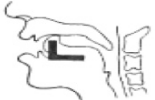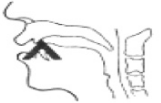Some theory...
Korean consonants were created to appear as the shape of the tongue or other parts of the mouth during enunciation. Particularly in the case of ㄱ, ㄴ and ㅅ, for instance, it's as if you're looking from the left side of a head split cleanly down the middle between the eyes.
Velar consonants are those articulated using the back part of the tongue against the back ("velum") part of the mouth.
alveolar consonants are those articulate with the tongue against or close to the "superior alveolar ridge," which is to say, the alveoli (or "sockets") of the upper teeth.
dentals, sibilants and chuintants are fricative consonants made by directing a stream of air with the tongue toward the teeth including chuintant or "hissing" sounds such as the beginning of /ship/ or /genre/ (as pronounced in English).
 |
 |
 |
Consonants and their names, i.e.: what they're called in Korean
| Consonant | Name | Approximate romanization |
|---|---|---|
| Gutturals | ||
| ㄱ | 기역 (giyeok) | g/k |
| ㅋ | 키읔 (kieuk) | k |
| Dentals | ||
| ㄷ | 디귿 (digeut) | d/t |
| ㅌ | 티읕 (tieut) | t |
| Bilabials | ||
| ㅂ | 비읍 (bieup) | b/p |
| ㅍ | 피읖 (pieup) | p |
| Dentals/sibilants/chuintants | ||
| ㅅ | 시옷 (siot) | s(t) |
| ㅈ | 지읏 (jieut) | j/ch |
| ㅊ | 치읓 (chieut) | ch/t |
| Nasals | ||
| ㄴ | 니은 (nieun) | n |
| ㅁ | 미음 (mieum) | m |
| Aspirants, liquids and other | ||
| ㅎ | 히읕 (hieut) | h |
| ㄹ | 리을 (rieul) | r/l |
| ㅇ | 이응 (ieung) | 0/ng |
Useful links
- Wikipedia: Hangul
- Korean Consonants and How to Pronounce Them Correctly
- 90-day Korean: Korean Consonants—Letters of 한글
- Bruce, the Korean
- Langoinstitute: Korean Pronunciation Tips, Part 1: Consonant Sounds